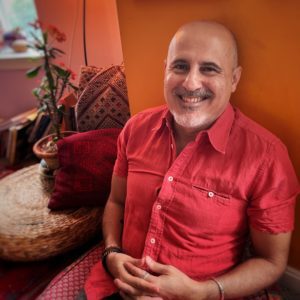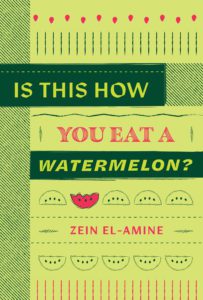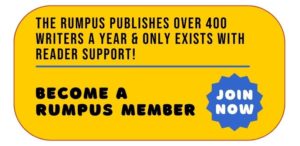
Zein El-Amine’s debut short story collection Is This How You Eat a Watermelon? (Radix Media, 2022) spans continents and perspectives, providing an inspiring and fascinating journey into the poetry in his prose. His development as a writer of both prose and poetry has been influenced by both spoken and written literature, including life experiences, where he has faced obstacles as an Arab American writer.
Zein El-Amine, born and raised in Lebanon, has an MFA in Poetry from the University of Maryland, where he teaches classes on Arabic language and culture. Rather than conform to the limited narratives that receive the most mainstream success, El-Amine is a risk-taker, and has published his poetry and prose in many venues, including Wild River Review, Beltway Quarterly, and Jadaliyya.
During an extensive email correspondence over the course of a couple months, we discussed El-Amine’s writing influences and inspiration, the construction of his short story collection, and what impact he hopes to accomplish with his collection.
***
The Rumpus: Who were some of your earliest inspirations? Were they all other authors or did other factors come into play when you started writing?
Zein El-Amine: What drew me to writing is reading. I was an avid reader since third grade, and that love of reading came from my family’s love of literature and storytelling. As for poetry, it was the oral tradition of the form that attracted me. I spent a lot of time in south Lebanon at a time when people entertained themselves by telling stories and competing in poetry slams, called Zajal in Arabic. In my high school years in Bahrain I had great American teachers who were passionate about literature, and that impacted me greatly.
Some of my earliest inspirations were authors like Mark Twain and the Western genre as a whole. The first two books I read in English were Tom Sawyer and Adventures of Huckleberry Finn. I went through years where I would binge on one author or another. For example, I had my Isaac Asimov year, then my Stephen King year, then my Louis L’Amour year. After that I had a long stretch where I read everything that Kurt Vonnegut wrote, but what really made me fall in love with the craft were writers that I read in my teenage years, in my attempts at escape in college: Flannery O’Connor and Raymond Carver. In terms of poetry I was very much influenced by Forough Farrokhzad and Galway Kinnell (reading his The Book of Nightmares was a game changer), and Palestinian poet Taha Muhammad Ali (who taught me the art of whimsy). Lastly, Carolyn Forche’s early poetry had a great impact on me especially as a poet in exile.
One experience that stood above all was reading Ulysses in class and then rereading it as I took students to Ireland to walk in the footsteps of the characters in that story. We would walk for a day and then settle in a “cozy” in the back of a pub to unpack one of its eighteen chapters. James Joyce had the most influence on me as a writer. That masterpiece has become a perpetual writing workshop for me.
Rumpus: You also write in multiple genres so I am curious about the different approaches you take with each genre? Do you think writing in many genres has improved your writing as a whole?
El-Amine: I always say that I am a storyteller first and foremost and the stories decide the genre for me. For example, there are stories that I tell through poetry and others that I tell through prose. All of the non-fiction that I have written was solicited, but I prefer to write in that genre because it opens up spaces for me to tell a bigger truth. My earliest writing was mostly poetry, but I have always had short stories and novels buzzing around in my head. I thought that my poetry manuscript would be published before my collection of short stories, but that is not what happened. I am working on several short stories now that are stand-alone stories, but the intention is to string them together into a novel. Also, I have had short stories that were condensed into a poem, and poems that I changed into a short story. I find that whenever I am immersed in a text, the work itself starts to speak to me and helps me shape it in its natural genre. Another connection is that I find that poetry can be used to give texture to a piece of prose. That is something I learned from teaching James Joyce’s works, especially A Portrait of the Artist as a Young Man and Ulysses.
When it came to writing Is This How You Eat a Watermelon? I had experiences that I wanted to relay, especially about my childhood in Lebanon. These were dramatic events charged with trauma. At the same time I began to see how the way of life in those years seemed to be from a past century; these traditions were all disappearing with my parents’ generation. Although this is tragic, it made for fertile ground for creative writing. I wrote poetry and prose sporadically until I switched careers late in life and enrolled in an MFA program; that transition gave me so much time and inspiration and forced me to develop a steady writing routine that I maintain today. Those years were packed with literary journeys that I conducted to Egypt, Ireland, and Morocco. They stoked my creativity and lent me new inspirations for writing. I also have had many friends who encouraged me to write the stories that I told at social gatherings, so that built my confidence in my storytelling abilities.
Rumpus: You mention that your publishing career has not gone the way you anticipated, so I would like to know more about your experience with the publishing industry. What are the most rewarding aspects of publishing? Have you encountered many challenges when publishing and promoting your texts?
El-Amine: Publishing lends legitimacy to your work and opens up opportunities to perform and teach. In my case even having a few poems published opened up a teaching opportunity for me, and I received invitations to read at different venues and events. Also, as an activist, I promote causes that I am involved in through my writings and public readings.
I was lucky when I started sending my work out because I had three poems published in three different journals after submitting only a handful of times. After that I learned more about the publishing world and its difficulties. I taught a class on publication where I gave the students extra credit if they submitted their rejection letters to me and read them in class. I wanted them to acquire a thick skin to minimize the demoralization and creative paralysis that comes with rejection.
Having said that, I do believe that Arab writers have to overcome more obstacles when it comes to getting our works published. I now look closely to see if the publisher or the journal that I am submitting to has published people of color. If that is the case then I look to see if they have published Arab American writers. If the latter is the case then I feel that I have a fair shot at getting my work accepted. I cannot say for sure why there are added difficulties for Arab writers, but I suspect there are political motives behind them.
Rumpus: As an Arab American writer, do you feel like you are penalized or further marginalized for not adhering to simplistic narratives that dominate in most Western countries such as the evil terrorists who hate freedom or the oppressed woman who must escape her culture?
El-Amine: I believe that I was penalized for trying to break out of those narratives. Not only that, but there is always an expectation that I will write and read works about war or oppression when I want to write about the human condition in general.
Rumpus: Was this your main intention for writing Is This How You Eat a Watermelon?—to write about the “human condition in general?”
El-Amine: My goal was to write a series of stories about Beirut and the characters that inhabit it. These stories were inspired by both the splendor and absurdity of living in that city. I wanted to show my city in a way that it has never been shown and in a way that speaks to its contemporary state. I left out several short stories; they had to be written as foundational back stories but did not belong in the completed collection. The best way to think of that is that the starter stories were the part of the iceberg that lies below the water that allow the tip to rise above it. Once I finalized the first three stories—“Sharife vs the Party of God,” “Is This How You Eat a Watermelon?” and “The Sayed and the Snow Woman”—I realized that there were stories that I had completed and published that fit with the collection.
After I had “lived in” the stories that I was writing, I added one set in the United States, “Killdeer,” but it is connected to my home in south Lebanon. It is about the transference of ghosts and was the most challenging story to write because I was experimenting with a new genre. At that point I realized that each of these stories, despite being fictional, represented a pivotal point in my life. It was then that I added stories that were largely autobiographical like “Send My Regards to Your Mother,” which is based on my arrest and near “disappearance” at the hands of the Bahraini government. I then included “Birds of Achrafieye,” a story based on an experience that I had of being trapped for 43 days in a school located in the epi-center of the Lebanese Civil War (this was at the beginning of the war) and “Groom,” based on my encounter with an abused monkey in Saudi Arabia and the truths that I learned from that encounter. That last one was another pivotal point in my life.
Rumpus: The main character in “Send My Regards to Your Mother” has your name. What influenced your decision to keep your name in that story but not the ones that are also somewhat autobiographical?
El-Amine: “Send My Regards to Your Mother” is the most true to life of all the stories in the collection. It was a story that had been solicited as it deals with my imprisonment and potential disappearance by a brutal regime. Some think that this is the sort of story that “writes itself,” but the truth for me is that I have heard and read and watched so many stories of imprisonment that I had to find a way to write it that made it stand out. One day I told the story in a creative writing workshop, and one of my students told me that there is something funny about the story. I could not remember any humor in it, but he pointed out that particular parts, especially how a wrongfully imprisoned student wore a shirt that read “That’s Right We Baaaaad” with inebriated cats smoking and drinking. My student thought it was laughable that when the guard asked one of the prisoners to gather his things, the only thing the prisoner had to take with him was a pair of blue shorts that he used as both a pillowcase and a towel during his time there.
The titular short story “Is This How You Eat a Watermelon?” was built around a cousin of mine who was such a mischievous presence in our lives that this made him unforgettable, so it is not directly my own experience. He was a prankster that caused me a lot of embarrassment and even unintentional physical harm. I built a story around him that grew until this main character became a stand-in for the city of Beirut itself. I finished the story before Lebanon collapsed under multiple maladies: the economic chaos, COVID-19, corruption, and the devastating harbor explosion. But after witnessing all that, the story took a turn in terms of the ending, which matched the fate of that city.
Stories like “Sharife vs the Party of God” and “The Sayed and the Snow Woman” are based on lived experiences that relate to my ancestral home, Deir Keifa in south Lebanon. That place is such a fertile ground for stories that I will be writing about it for a long time. Part of the reason is that it represents a time and a place that does not exist anymore. The way of life that existed in that setting has completely evaporated with time, and to write about those times and traditions is my way of preserving them. I have lived in all the places that I write about in the collection: Beirut, Saudi Arabia, Bahrain, and the US, though the experiences are not all my own.
Rumpus: Your stories often find humor in tragic or difficult situations, and you discussed a student who found your imprisonment in Bahrain somewhat funny. How do you incorporate those lighthearted elements into your stories without being dismissive or insensitive about traumatic situations?
El-Amine: Humor, and more precisely whimsy, is very important in my writing whether it is poetry, fiction, or nonfiction. I believe that we wield whimsy to gain the malleability to adjust to the harshness of the human condition, and this is especially true when you live in war torn countries. I admire how the Lebanese deal with war with humor in order to maintain their sanity and endure. I also found that the most oppressed people in the world tend to be the funniest. Palestinians are the best example of a people that wield humor to lighten their oppression and steel their stamina for survival.
Rumpus: So you are saying the tragedies themselves are what brings the whimsy to your narratives, which is a completely new perspective to me. Seeing that whimsy in tragedy, did it come from your lived experiences or from reading about tragedies or some combination of the two? Do you see any authors who employ this technique, who may have provided you with inspiration to bring that to your stories in Is This How You Eat a Watermelon?
El-Amine: Yes, Palestinian poet Taha Muhammad Ali showed me through his work how to wield whimsy and humor even when you are addressing the sorry state of your existence. Also, Charles Simic has been a great example of a writer who uses humor in his work effectively.
Recently I read Amara Lakhous’ Clash of Civilizations Over An Elevator in Piazza Vittorio that gave me a great insight into Italian society as seen by an Arab immigrant. And of course I cannot talk about humor in literature without mentioning Kurt Vonnegut’s work, which made art out of absurdity. He introduced me to new possibilities of political and societal commentary.
Rumpus: Much of our discussion has centered on what you have gotten out of literature, so I am curious: What do you hope readers will take away from Is This How You Eat a Watermelon?
El-Amine: I want their view of the world to be altered for the better. The works are subversive to different degrees, but I did not write them with that intention; that is just how they turned out. Most of them have a political undercurrent that is there for those who want to look for it, but I do not care if readers do not see the political charge. I hope that the readers experience the catharsis that I had when writing these stories, and that each one will send the reader coasting through the narrative as opposed to completing the stories for them and ending their engagement with the themes. I strove to create the kind of work that rivets the reader the way that the hakawatis (storytellers) used to do in cafes and public venues in Arab cities like Baghdad, Beirut, Damascus, and Jerusalem, bringing the impact of the spoken word into written literature.
***
Author photo by Jen Lemen






